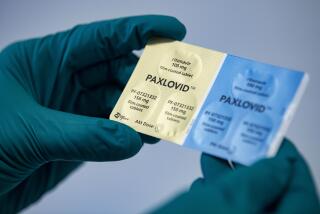Drugs for rheumatoid arthritis work wonders. So why don’t all patients take them?
- Share via
Rheumatoid arthritis is an autoimmune disorder that progresses from joint pain to joint destruction and disfigurement. But that progression can be dramatically slowed by a class of medications called disease-modifying antirheumatic drugs, or DMARDs for short. If started early, these drugs can preserve patients’ joints for years, allowing them to continue working and improving their overall quality of life.
So why aren’t all RA patients taking them?
That’s a question that a group of researchers from Stanford, Brown, Harvard and UC San Francisco set out to answer.
They looked at four years’ worth of data on more than 93,000 RA patients from around the country who were enrolled in Medicare managed care plans. Between 2005 and 2008, the proportion of patients who took DMARDs ranged from 59% to 67%. But the one-third or more of patients who didn’t get the drugs wasn’t spread randomly across the country. In fact, the researchers noted several groups of patients that were less likely to get the dugs.
Among them:
Patients who were at least 85 years old – about 42% of them used the drugs, compared with 72% of Medicare beneficiaries between age 65 and 69.
Men – 61% of them used the drugs, compared with 64% of women.
Nonwhite patients – nearly 57% of black patients and 58% of patients whose race was described as “other” used the drugs, compared with 64% of white patients.
Low-income patients – 55% of them used the drugs, compared with 64% of patients who were not low-income.
Patients who lived in certain parts of the East Coast – about 52% of patients in the South Atlantic region got the drugs, along with 59% of patients from the Middle Atlantic. By contrast, 67% of patients in the Pacific region got them.
Patients who lived in areas with a doctor shortage – 62% of those patients got the drugs, compared with more than 67% of patients who had access to plenty of doctors.
The study is the first to look at patterns of DMARD drug use across the entire country, according to the researchers. Though a substantial proportion of patients aren’t taking them, it’s hard to know how much lower that number should be. For instance, some patients may not be able to take the drugs because they cause dangerous interactions with other medications that they need to address more pressing health problems. That might help explain the particularly low use among the oldest patients in the survey, the researchers said.
Cost is almost certainly a factor, but the researchers couldn’t nail that down because they couldn’t tell what kind of prescription drug coverage the patients had. They noted that some of the 17 DMARDs can cost more than $4,000 per year, while others cost less than $1,000. Even with that price tag, however, the copayments may be too high for some patients.
“Given the enormous individual and societal costs associated with rheumatoid arthritis, and increasing substantial evidence that DMARDs can reduce these costs, variations in DMARD receipt based on demographics, socioeconomic status, and geography are unacceptable,” they concluded.
The study was published in Wednesday’s edition of the Journal of the American Medical Assn.





